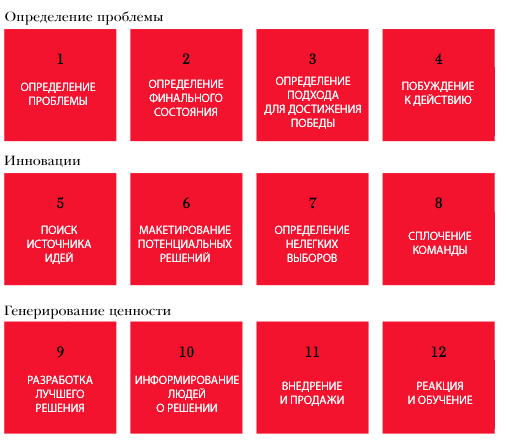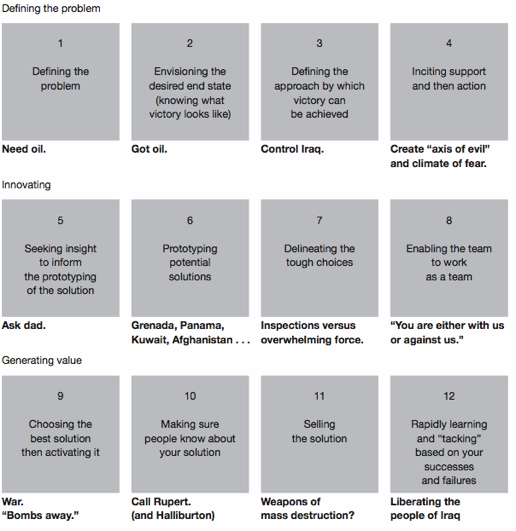Scheme design process from the American Institute of Fine Arts (AIGA)
The American Institute of Fine Arts ( AIGA ) made a diagram explaining the design process. By design is meant the broadest understanding of it, that is, thinking, inventing, developing and implementing a solution to a specific problem.

Being wits, the creators of the scheme illustrate its use like this:
')

I tried to get rid of one of my urgent problems on these points and, I must say, I found a solution that worked and worked as it was intended.
Details on each item are listed in my record here: nordisk.pp.ru/design/58
There is also a link to the original brochure, if you don’t like my translation efforts :)
For Habr, I rewrote the record a little in terms of shortening and laid out under the cat.
So, here is a description of the points of the design development scheme from AIGA:
In conclusion, I note that this is only one of the many schemes of the design process. There are many others: linear, parallel, cyclic, generic, and detailed. This scheme seemed curious to me and being applied in practice even helped in some ways, so I recommend paying attention to it.

Being wits, the creators of the scheme illustrate its use like this:
')

I tried to get rid of one of my urgent problems on these points and, I must say, I found a solution that worked and worked as it was intended.
Details on each item are listed in my record here: nordisk.pp.ru/design/58
There is also a link to the original brochure, if you don’t like my translation efforts :)
For Habr, I rewrote the record a little in terms of shortening and laid out under the cat.
So, here is a description of the points of the design development scheme from AIGA:
- Identify the problem . Successful teams first identify the problem. It is necessary to express it in an understandable language and limit its scope. Problem statement is part of the solution.
- Definition of the final state . It is necessary to clearly describe the conditions of victory.
- Determining the approach to achieve victory . Once you know what the goal is, you
it is necessary to identify ways to achieve it. You need to map these paths and embed it in your minds.
all participants in the process. Everyone should know where and how they go. - Motivation for action . It happens that the team does not want everyone to go the intended way. It is necessary to encourage, convince or make them do it. It may be necessary to help someone, to teach someone.
- Search for inspiration and source of ideas . When all the preparations have been made, you need to start generating ideas, look for inspiration and do research that will tell you how to achieve the goal.
- Layout of potential solutions . The best ideas found in the previous paragraph should gain simple
material form in this. You need to make prototypes of things or processes and see how they can work. - Definition of hard choices . Since your ideas will gain a material look and you will start using them,
one or other problems will immediately come up. You should even intentionally look for these problems.
Will the solution be too expensive? Does he have hard technical problems or other flaws? - Team building In the process of finding a solution, there may be friction between team members defending their points of view. Designers should play a consolidating role here, seeing the difference in the views of different team members and noting the common thing that can unite them. Although you can simply apply command methods to force everyone
- Choosing the best solution and its development . This is the culmination of all previous points. That decision is chosen
which is recognized as the best and begins its immediate development. - Informing people about your decision . This is what is usually called marketing or advertising and PR of your decision. About him should know more people.
- Sales At this stage, your decision is sold and brings you money.
- Quick learning and reaction based on your success or mistakes . The most effective teams are always
are learning. Designers rethink, correct and improve their decision.
In conclusion, I note that this is only one of the many schemes of the design process. There are many others: linear, parallel, cyclic, generic, and detailed. This scheme seemed curious to me and being applied in practice even helped in some ways, so I recommend paying attention to it.
Source: https://habr.com/ru/post/55572/
All Articles